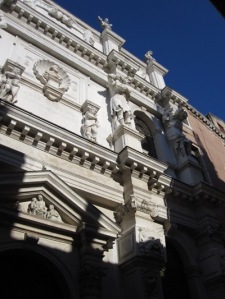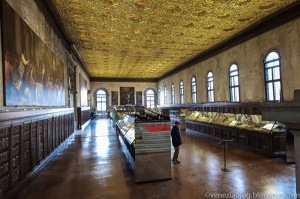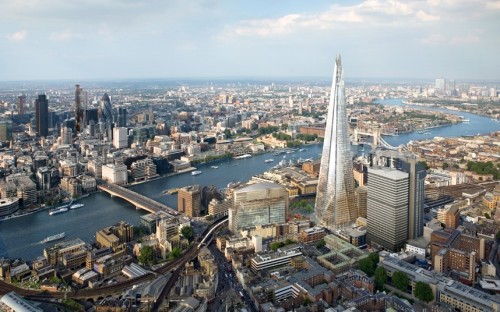It’s been a long time since I posted, for a variety of reasons. I am back, because we have just had five excellent days in Venice, remarkably sunny, but cold to freezing. Long johns, however, made walking a pleasure and vaporetto rides along the Grand Canal a sheer delight.
A rule we have for Venice made the visit even more enjoyable than usual. Dress smartly, and the odds are that you will be taken for a Venetian, until you open your mouth, whereon you may, as we were, be treated more or less as an equal, an unusual tourist at least. The service is better and friendly in a subtle way that differentiates from just “happy to see you to take your money”.
Dressing smartly, when one is our age and it is late in the year, means a smart overcoat, jacket, shirt and tie, and shoes for me, and similarly appropriate for Madame, with the added chic of a fur hat. But a sports coat, shirt, tie and shoes, never trainers, at any age gives you a chance of being mistaken as a non-tourist. Not overtly gaping at the amazing sights around every corner helps too, and murmured conversation.
Never, ever, wear a rucksack, especially with a bottle of water protruding…
In the week, we were only bothered once by the incessant “Gondolé, gondolé” invitations addressed to every obvious tourist. And then only when we spoke English in the hearing of a couple of gondoliers. And our ‘dress code’ led to a couple of very interesting conversations that would simply not have happened otherwise.
Of course, it’s different strokes… You may not care about anything but just enjoying the city, especially on your first visit, particularly by dressing as comfortably as you can, down to the trainers, because Venice is walking, and I can’t fault that. It’s just our peculiarity. And having worn a tie throughout my working life, I am totally at ease with that, though many people rather suddenly no longer seem to be.
So what were our interesting encounters ? First, another digression. I cannot praise highly enough (I believe I have before) Venice Osterie by Michele Scibilia, the must-have guide to eating in the city, other islands and (a little bit) on the mainland. We have never, ever, had a bad experience using her guidebook, but we had some truly dreadful ones previously. Of course there are excellent spots she does not mention – we found two during this stay – and each edition swops some in and out, for variety. It is only sold in two places in Venice, the train station and the small information office and (excellent) bookshop at the main San Marco vaporetto stop – the little elegant, white, domed building, previously I suspect an orangerie, on the left as you face inwards from the lagoon. Or see if the book is in your local map and travel bookstore.
Our first unusual conversation was over dinner in da Remigio, in Castello, much favoured by the locals, some of whom exchanged hugs with the waiters on arrival, with much banter. Our neighbours at the six-place table arrived just after us, he in a suit, with open-neck white shirt but an elegant silk scarf, she as formally dressed as my wife. Both, we suspected, in their late-50s, though it is definitely getting more difficult to tell ages of people who are ‘of a certain age’.
After polite nods, they got on with three swift courses of antipasto moistened with small servings from a bottle of Soave – it was not half finished when they left.
After about 20 minutes, he suddenly turned to me and started talking in excellent English. We had been summed up as unusual tourists, potentially interesting. Oh, it was our seventh visit to Venice. Where were we staying ? The Priuli nearby? Excellent choice. They lived around the corner, had been coming to da Remigio for 40 years.
The talk quickly turned to politics – it was the day Berlusconi was dismissed from the Senate. He was interested that I followed enough Italian politics to recognise the names of party leaders and one high-profile would-be leader, and ask about other aspects. His wife smiled a lot, but her English was clearly not up to a lot of our conversation and he sometimes translated for her.
I had the usual foreign reaction to Berlusconi, but he tentatively defended him. “Of course, he went mad over the last five years, but he did a lot for Italy – high speed trains, new autostrada, and he found the money for MOSE.” That is the giant project of 53 underwater gates that will rise in the three entrances to the Venetian lagoon and hold back the aqua alta, the high tides which several times a year flood much of the city to a greater or lesser degree. http://www.telegraph.co.uk/travel/destinations/europe/italy/venice/10376184/Venice-tests-massive-movable-flood-barrier.html
“After all, he was prime minister for a record time, and 10 million people voted for him.” Clearly, our neighbour was one of them.
MOSE would be the saving of the city, he had no doubt. People would invest – though there seemed to us no shortage of restoration projects on decaying palazzos – there would be an influx of foreign residents. It would become an international city. Already, he said, many of their friends had moved away, and they had a number of English friends as Venice residents now.
Talk veered to the economy. Italian banks, he said, had mostly avoided the derivatives shambles and were not in bad shape.
“Sienna,” I said. He roared with laughter, said to his wife : “Strordinario, this gentleman really knows Italy.” Well, I said, as a retired journalist I do try to keep in touch with events, and we talked of the collapse of the Monte di paeschi di Sienna, which claims to be the world’s oldest bank, with a $4 billion hole through bad management and worse governance.
Finally, as they were preparing to leave, he pointed proudly to a lapel pin. We had taken him to be a lawyer, a notary or some such. “I’m a professional sommelier.” With much handshaking and beaming smiles all round, they left.
I was to hear different Venetian views of Berlusconi the next day.







